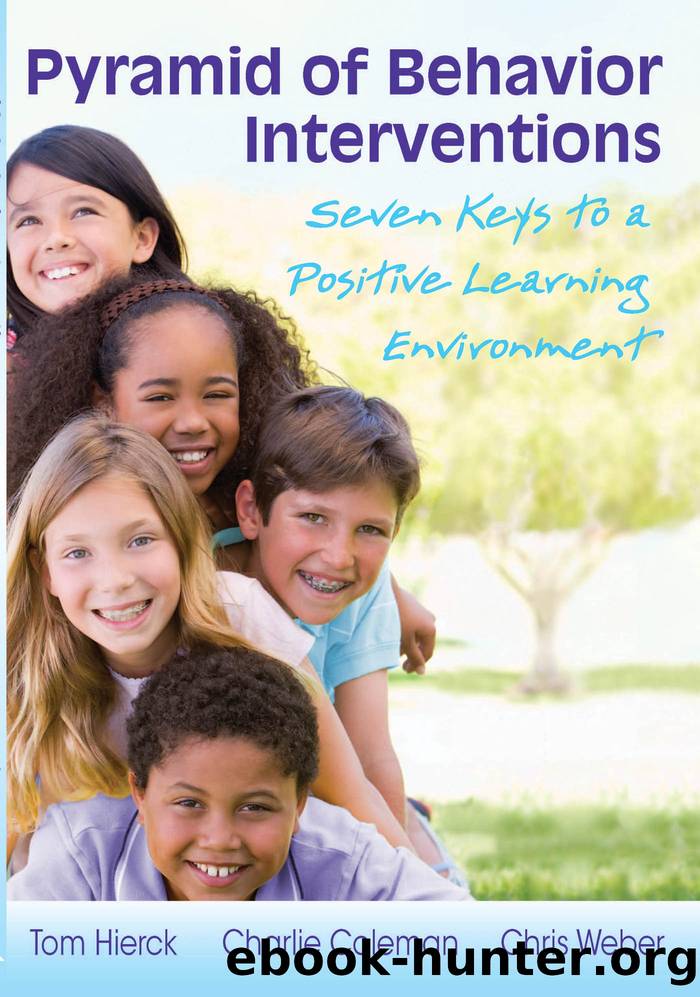Pyramid of Behavior Interventions by Hierck Tom;Coleman Charlie; & Charlie Coleman & Chris Weber

Author:Hierck, Tom;Coleman, Charlie; & Charlie Coleman & Chris Weber
Language: eng
Format: epub
Publisher: Solution Tree
Published: 2011-08-15T00:00:00+00:00
4:1 Positives Challenge
The 4:1 positives challenge encourages the adults in the building to provide at least four positive interactions to a student for any one negative interaction they have with that student. These interactions range from small and informal to large and formal. There is no single correct way to do it, but it is critical to provide more positive than negative interactions. Positives may be verbal and they may be tangible, such as âcaught being goodâ cards, but they should be liberally given.
The behavior matrix is a useful tool to support the 4:1 goal. Note that all of the behavior descriptions are positively phrased and that the authors have avoided the words no and do not. If the behavior matrix states, âDisplay good manners,â then teachers will recognize students whenever they display this behavior.
These following two examples, one from high school and one from elementary school, briefly describe the effective use of the 4:1 positives challenge when linked to behavior expectations.
Danielle, a high school student, was struggling in most subjects, but especially in math. In a meeting with her parents and the assistant principal, it was concluded that most of her problems stemmed from behavior, not ability. Together, they identified the key behaviors that needed to improve, including attending class regularly and showing up for extra help at least twice a week. The teacher kept track of Danielleâs attendance and offered rewards of free time at the end of class on Fridays if Danielle had a week of perfect attendance. In addition, the assistant principal held mandatory homework help on Tuesdays and Thursdays, where she provided lots of positive encouragement and cookies. Over the course of one school term, Danielleâs attendance improved dramatically, her teachers noted increased participation from her in class, and her marks went up from the Câ range to the C+ and B level.
Mikey was a rambunctious fifth grader who had difficulty staying in his seat and keeping his hands to himself. After a number of visits to the office, Mikey, his teacher, his mom, and the principal had a meeting to discuss a new behavior plan. This individualized plan focused on Mikey staying in his seat at seatwork time and not hitting or poking neighboring students. The teacher already gave out raffle tickets for good behavior in his class. It was agreed that Mikey would get a raffle ticket every fifteen minutes that he was not disruptive. This equated to four tickets per hour, for five hours each school day. At the end of each week, the teacher held a drawing in class. Sometimes the prizes included pencils and small toys, other times the reward was extra time on the playground at the end of the week. Despite the fact that Mikey was getting inundated with raffle tickets every time he was caught being good, Mikey was not winning the weekly draw. One day when Mikey was away, the teacher checked his desk. Amid the mess inside was a neat, tidy stack of unentered raffle tickets.
Download
This site does not store any files on its server. We only index and link to content provided by other sites. Please contact the content providers to delete copyright contents if any and email us, we'll remove relevant links or contents immediately.
The Art of Coaching Workbook by Elena Aguilar(50963)
Trainspotting by Irvine Welsh(21517)
Twilight of the Idols With the Antichrist and Ecce Homo by Friedrich Nietzsche(18501)
Fangirl by Rainbow Rowell(9093)
Periodization Training for Sports by Tudor Bompa(8168)
Change Your Questions, Change Your Life by Marilee Adams(7633)
This Is How You Lose Her by Junot Diaz(6778)
Asking the Right Questions: A Guide to Critical Thinking by M. Neil Browne & Stuart M. Keeley(5630)
Grit by Angela Duckworth(5512)
Red Sparrow by Jason Matthews(5390)
Paper Towns by Green John(5086)
Room 212 by Kate Stewart(5035)
Ken Follett - World without end by Ken Follett(4643)
Housekeeping by Marilynne Robinson(4328)
The Sports Rules Book by Human Kinetics(4288)
Double Down (Diary of a Wimpy Kid Book 11) by Jeff Kinney(4204)
Papillon (English) by Henri Charrière(4195)
The Motorcycle Diaries by Ernesto Che Guevara(4009)
Exercise Technique Manual for Resistance Training by National Strength & Conditioning Association(3955)
